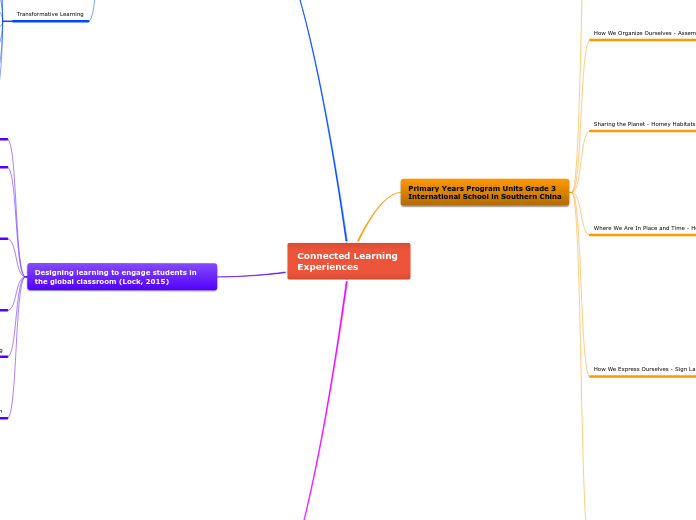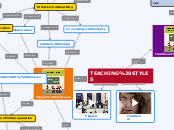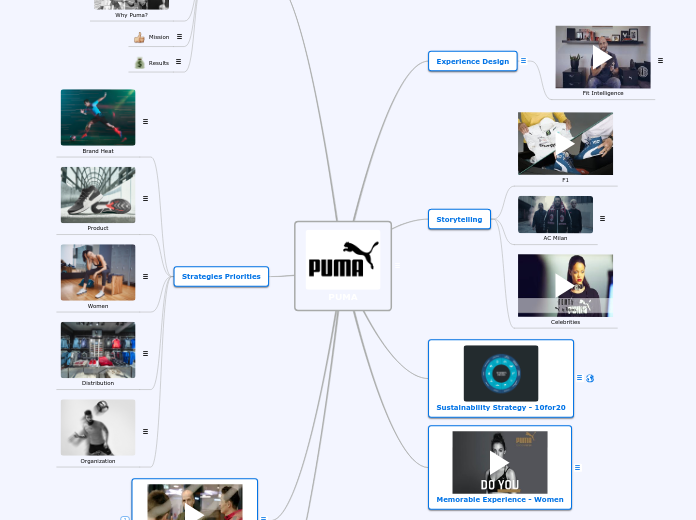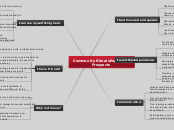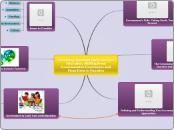Connected Learning
Experiences
The Community as a Resource for Learning (Furco 2010)
force out of comfort zones
meets individual interests and empowers students
partnerships and collaboration within the learning environment,
constructivist approach of problem solving through a common problem forges co-operation,
Designing learning to engage students in the global classroom (Lock, 2015)
Design and facilitation for collaboration
Connecting with expertise
Beyond the school
innate ICT integration amplifies collaborative learning
Blogs
Wiki
Google Docs
There is a shift from singular 'learning events' toward collaborative learning experiences
HPL How People Learn framework- Bransford, Brown and Cocking's
Subtopic
Assessment Centred
Knowledge Centred
Community Centred
Learner centred
Peer to peer learning is amplified by technology through learning collectives
The world is rapidly changing and the use of new technologies are needed to keep up with the innovation
Connecting the Dots (Kozak, 2014)
Transformative Learning
Assessment as, for and of learning is emphasized
deeply integrated use of technological tools and real-world sources
learn in the community as well as the school environment
Learning through projects
adaptive learning is personalized to the learner
Thinking about past-present-future
Critical thinking is mandatory
Change is required to meet needs
Interconnected learning strategies
Sharing Responsibility for Learning
Inquiry
Considering Alternative Perspectives
Real World Connections
Acting on Learning
Integrated Learning
Learning Locally
All education is environmental education
Primary Years Program Units Grade 3
International School in Southern China
How the World Works - Buildings and Structures
Students build a 3D model of a building or structure (Eiffel tower) using found material and present to the school community with a history and relevant information including a map of location. GLOBAL
Earn student researches a famous building in their home country or in a location of their choosing and presents about it GLOBAL
Learn about different animal homes - bee hives, ant hills, beaver dams GLOBAL
Learn the three pigs story and read several different versions including the one about different world architecture. GLOBAL
Learn about different homes around the world - yurt, apartment, houses with grass roves, igloo etc. GLOBAL
Learn about famous buildings around the world GLOBAL
How We Express Ourselves - Sign Language
Learn about Helen Keller GLOBAL
Students create bully free zone signs - immediate LOCAL COMMUNITY
In small groups , students create a culminating task - a presentation for visiting students about one form of communication that has a brief explanation, overview of how to do it and an interactive activity for guest learners.
Students study many ways that people express themselves through signs, languages, naval semaphore flags, morse code, sign language, road signs etc., different alphabets like Korean, Arabic, Japanese, braille, hieroglyphs, body language, cave paintings, graffiti, map symbols, international signs and symbols, anglo saxon runes, roman numerals GLOBAL connections
Learn how to write their name in many different ways
Where We Are In Place and Time - Here and There
Look at old maps of the local city and observe how it has changed over time. Do a local walk about and create maps of the local area/campus/sports complex
Students make a brochure of a local attraction including all of the relevant information for a tourist to visit it using various research tools and online images, searches. They produce a document in Microsoft Publisher, print it, present it and display it. LOCAL
Students study the local area including maps and history relating to international trade that is relevant to many students at the school GLOBAL TRADE, NATIONAL TRADE
Sharing the Planet - Homey Habitats
The class researches all of the different habitats around the world. The class decides as a group which habitat to look at in-depth, and each member of the class chooses an animal from that one of the GLOBAL habitats (ie the Arctic). We decorate the classroom according to the look of the habitat (snowflakes) and each student chooses an animal in that habitat to do an in-depth research poster presentation about.
Understand the LOCAL and NATIONAL habitats, and go on a local hike/the local zoo
Online encyclopedias GLOBAL
Skype education interviews with Lion experts in Botswana and Shark experts at a research centre in the US GLOBAL
How We Organize Ourselves - Assembly Line
Students are asked to create interview questions about different roles in the school community. The private school where we worked had many people including groundskeepers, administrative staff, cafeteria workers, parent-teacher leaders, school leaders, sub-level coordinators etc. Each student had a different person to investigate and we made a giant 'school family tree' in the hallway with completed work.
LOCAL focus on the immediate community
Students learn about different jobs in the world, in their family and in the school.
GLOBAL Skype Education interviews with sparky the fire dog in the US
Who We Are in Place and Time - We are Unique
Zodiac Signs GLOBAL
Research the mearning
LOCAL - Chinese Lunar Calendar
Research the meaning online, learn the story
Suki's Kimono Book suggests the importance of uniqueness
Find a photo on the internet to represent an aspect of yourself that makes you unique and share it with the class LOCAL TO GLOBAL
Study of relevant flags in the classroom, and then learning the song 'Waving Flag', talk about the meaning . GLOBAL
Ice breakers and teambuilding LOCAL
A focus on conflict resolution including understanding perspective with an introduction with the Dr Seuss book The Sneetches
Students research how to resolve conflict and create posters LOCAL
extremely brief look at real life scenarios online of current conflict areas like Syria (relevant because of Syrian students) GLOBAL
Each student during this unit would focus on introducing where they were from in the world, their family history, and special family traditions that they have.
Students create a kidblog to document learning over the course of the year and keep parents and family members abroad connected. GLOBAL
